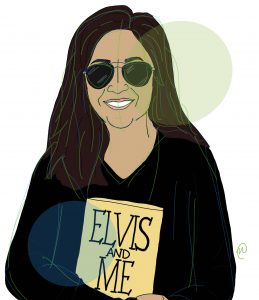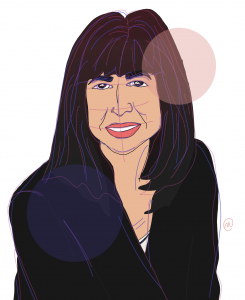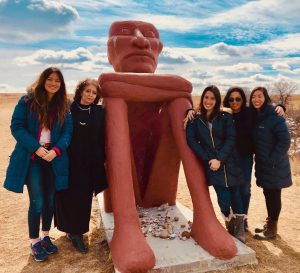9 Teaching Women’s & Gender Studies: Teaching Tools for Life
By Elena Tajima Creef and Rosanna Hertz, Wellesley College


In almost four decades as a department, Women’s and Gender Studies (WGST) has become critical to Wellesley’s mission as one of the leading historical women’s colleges in the US.[1] Today, Wellesley students come to believe they need to take at least one Women’s and Gender Studies course before they graduate, in part as a way to explain why they came to Wellesley in the first place. As senior WGST professors, we see ourselves as intellectually focused on intersectional and transnational analyses that provide students with critical tools to face, and hopefully, change the world.
We have always seen our mission as three-fold. First, as historian Nancy Cott so eloquently noted about US American feminism, we have sought to understand how gender has and can be made to “matter and not matter” at the same moments in time (1989). Second, we have always taught that the intersections of gender, race, class, sexuality, ability and ethnicity in a transnational context shape social realities. Third, we engage pedagogical strategies that address the complexities of human identity as we expand the theoretical basis for Women’s and Gender Studies as arenas for scholarship, service, and teaching. Fast forward to 2020. We are grateful for the opportunity to revisit what happens in our classrooms and how our students take what they are learning with them after they graduate from college.
One of our departmental traditions has been to give every newly declared WGST major a small double-headed screwdriver with the inscription, “WGST: Tools for Life.” This portable toolkit is both a highly useful everyday object as well as an abbreviated salute to Audre Lorde’s famous essay, “The Master’s Tools Will Not Dismantle the Master’s House” in which she so eloquently argued for the dismantling of systems of oppression and racist patriarchy. Like WGST departments everywhere, we are committed to helping our students translate what they learn inside the classroom into activist contexts that can change lives in the world outside of the university.
The tools we give our students are not simply conventional ones found in theory and methods (though we do teach those as well), but rather are what we consider empowering life lessons for how to take their knowledge outside the classroom as critical thinkers and activists who are learning to see the world in new ways—through an intersectional lens of race, class, gender, sexuality, and social justice. Or, our interpretation of feminist praxis.[2]
Over the years, we have been able to create a range of experiential learning opportunities consisting of faculty-led student trips that have had a profound impact on our majors. Experiential trips like these are a pure labor of love on the part of our WGST faculty and go far beyond the expectations of our work at the college. We feel fortunate to teach at a campus that has the resources to support these kinds of trips. Our students are meeting a range of social justice activists who embody compassion, charisma and resilience in their humble style of leadership. We consider passion and compassion to be the foundational bedrock for what we do in our department as we strive to create a future generation of activists.
The United Nations Trip[3]
Our department has taken its graduating seniors five times to the United Nations in New York for the annual Commission on the Status of Women. This unique gathering consists of delegates, invited panelists, and a regularly scheduled side event featuring Non-Governmental Organizations (NGOs). Prior to attending the trip, students attend several departmental meetings to discuss readings about the UN and human rights.[4] While attending these events, our students have been able to listen to a diversity of women leaders from all over the world share how they are trying to create equity for women and girls as they look to each other and to the United Nations for support. Attending the meetings and the like, listening to the women’s demands, ultimately make visible and concrete the intricacies of the patriarchal system under which we all live. For example, while many countries have laws against domestic violence, sexual assault, and other forms of violence, the UN is a space in which delegates discuss how to implement these laws to provide women and girls with safety and justice.
Although the UN is not always effective for implementing long term change, this rare gathering of women from all over the world inspired our students to shift their perspective on their own position vis-à-vis the world. For example, our students have said at evening check-in meetings at the UN and then in a follow-up lunch meeting after we returned, that some of the most powerful and eye opening stories they heard were from women who shared how obtaining something as basic as a small gas cook stove made a radical difference between safety and danger in their lives. Women who owned a portable stove no longer had to walk for miles each day in the rural areas of Tanzania, Uganda, and Nigeria, among other African nations, searching for firewood, thus putting themselves at risk of physical attack. Similarly, during the year that focused on “The Girl Child,” our students were stunned to learn about systems of oppression surrounding the expectations for early marriage, sex, and reproduction that exist in many parts of the world. Most moving to the students were those panelists who traveled from their villages to garner support to increase marriage age for girls back home. The activists came to New York with the goal of returning home with a UN backed resolution that set a higher age for marriage and our students ultimately felt empowered by the women’s determination.
After the UN trip, students wrote a short paper based on the following prompt: “What are the possibilities and challenges of building alliances and relationships between the global South and global North in relation to women’s and gender issues?” This assignment was designed to help our students reflect on what they learned about forming alliances with women in different locations and how the UN offers one possible space for advancing human rights. From a WGST perspective, our students were able to observe real world challenges and solutions advanced by the activists themselves that previously had only been experienced as intellectual exercises in the classroom. At this particular meeting, we discussed the little known issue in the US that the federal government does not have a universal minimum age for marriage. Rather, each state sets its own laws. Approximately thirteen states do not have any set minimum age for marriage. The US did not sign on to a UN resolution in support of a minimum age because this would contradict its stance allowing states to determine and regulate matters related to family. A byproduct of the UN trip was that our students came to discover not only the challenges and complexities of international resolutions, but the hidden problems of these same issues here at home.
Alternative Spring Break Trip to Standing Rock
In November 2016, during the height of the #NODAPL protest that was unfolding on the Standing Rock Reservation in South Dakota (home of the Lakota Sioux Tribe), Elena Creef (co-author of this essay) asked students in her WGST seminar on “Representations of Women, Natives, and ‘Others’”[5] if they were interested in learning more about the Lakota communities. If so, they could travel with her to Pine Ridge, Standing Rock, and Cheyenne River where she has been doing research and volunteer work within the horse communities for the past six years.[6]
Three students of color took up the invitation to travel with her to the Dakotas in March 2017—and again in March 2018—on an alternative spring break service trip. While visiting these communities, students had the privilege and opportunity to learn about the many contemporary issues that the Lakota face.
Elena and her students volunteered at the Cheyenne River Youth Center, met with Standing Rock activist LaDonna Bravebull Allard, and visited several of the Water Protector peace camps devoted to creating community shaped by traditional Lakota spiritual values of respecting Mother Earth and the sacredness of Water.[7] They also spent a day in the small district of Bridger where United Church of Christ lay pastor Byron Buffalo shared his work in a “healing with horses” youth program. These students had never ridden before but were invited to saddle up and ride alongside Byron’s youth and experience for themselves the special bond between humans and horses.
In preparation for these trips, students wanted to donate to the community organizations they visited. They held a fundraising campaign (by designing and selling their artwork) and gathered an impressive collection of prom dresses from friends and faculty eager to support the Youth Center’s annual “Passion for Fashion” fashion show and prom night clothing collection.
Students were able to witness the complexities of how race and gender intersect with indigeneity, poverty, environmental racism, and the legacy of US settler colonialism; topics they had studied in Elena’s class. What moved the students more than anything were the countless examples of resilience, generosity, and cultural pride that were visible, even foundational, in these communities. Not only were their individual experiences transformational for the students, but they brought back to the Wellesley community a new context for social change and action. Indeed, several of the students have returned to these communities where they forged strong connections, made new friendships, and even accepted teaching positions after graduating with the Teach for America program in Pine Ridge.
These are just two examples of the kinds of experiences that our WGST department has offered its students in order to help them think outside the box of conventional classroom learning. Michele Tracy Berger and Cheryl Radeloff (authors of another essay in this collection) call this sort of civic engagement, “learning that benefits both the student (by expanding his or her abilities to apply knowledge across multiple contexts) and the community beyond campus (by providing volunteer labor and cultivating the next generation of community-minded individuals)” (2015, 63). While perhaps the skeptic who reads this might say that students could learn these concepts without leaving the classroom, in our estimation we became teachers in order to facilitate our students’ understanding of the injustices in the world and the legacies of those determined to challenge them in the name of social change and activism. Further, Berger and Radeloff remind us that WGST civic engaged courses are unique in that they demand that students analyze the historical circumstances and structures that necessitate their “service in the first place, as well as interrogate their own motivations to ‘help others’” (2015, 64). What could be a better feminist goal for a liberal arts education than to provide ways for our students to make a difference in the world?

Works cited:
Berger, Michele Tracy and Cheryl Radeloff. 2015 [2011]. Transforming Scholarship: Why Women’s and Gender Studies Students Are Changing Themselves and the World, Second edition. New York, NY: Routledge.
Cott, Nancy F. 1989. The Grounding of American Feminism. New Haven, CT: Yale University Press.
Freire, Paulo. 1983. [1970]. Pedagogy of the Oppressed. New York, NY: Continuum.
Halpin, Mikki. 2017, March 26. “Standing Rock Sioux Tribe Historian LaDonna Brave Bull Allard on DAPL Protests and Seventh Generation Activists,” in Teen Vogue.
Hurd, Kimberly. 2019, September 24. “Top 10 Colleges for Women’s Studies,” College Magazine.
Lane, T. M. 2018. “The Frontline of Refusal: Indigenous Women Warriors of Standing Rock,” in International Journal of Qualitative Studies in Education. 31(3): 197-214.
Lorde, Audre. 1984. “The Master’s Tools Will Never Dismantle the Master’s House.” Pp. 110-113 in Sister Outsider: Essays & Speeches. Freedom, CA: The Crossing Press.
Merry, Sally. 2006. Human Rights and Gender Violence: Translating International Law into Local Justice. Chicago, IL: University of Chicago Press.
Minh-Ha, Trinh T. 2009. Woman, Native, Other: Writing Postcoloniality and Feminism. Bloomington, IN: Indiana University Press.
Privott, Meredith. 2019. “An Ethos of Responsibility and Indigenous Women Water Protectors in the #NoDAPL Movement,” in American Indian Quarterly. 43(1): 74-100.
- We are proud that College Magazine recently ranked us as the top place to study Women’s and Gender Studies in the country. (September 24, 2019): https://www.collegemagazine.com/top-10-college-for-womens-studies/ ↵
- The concept of praxis comes from Brazilian education philosopher Paulo Freire (1970) which feminist educators have built on over the decades since. ↵
- We would like to thank our WGST colleagues, Sealing Cheng, Susan Reverby, Charlene Galarneau, Irene Mata, Jenny Musto, Dulce Natividad, and Betty Tiro who have been instrumental over the years in leading and preparing our students on the trips to the United Nations. The Centers for Research on Women at Wellesley College generously gave us their UN passes that made our participation possible. ↵
- For instance, students read several chapters from Sally Merry, Human Rights and Gender Violence: Translating International Law into Local Justice (2006). In the early years of our travels to the UN, our senior capstone seminar, “Transnational Feminisms,” was a requirement for participating on this trip. Since the capstone is rotated among the faculty with different thematic emphases, “Transnational Feminisms” is one option among several other courses offered by colleagues in other departments. ↵
- The title of this course pays homage to the work of feminist filmmaker Trinh T. Minh Ha’s Women, Native, Other (2009). ↵
- Elena is a lifelong horse woman who has been involved as a volunteer and a participant in several of the sacred horse rides that take place throughout the year. Her long term relationship with members from the community has made it possible for her to take students there in order to give them, as a beloved Oglala elder Chubbs Thunderhawk put it, “a real education” where they can see and experience reservation life firsthand. Mr. Thunderhawk’s comment and invitation paved the way for Elena to begin bringing small groups of Wellesley students to the Dakotas where they were warmly welcomed by all those they met. ↵
- To learn more about the role of Native women leading the peaceful protest at Standing Rock in 2016-2017, see Mikki Halpin (2018), T.M. Lane (2018), and Meridith Privott (2019). ↵

